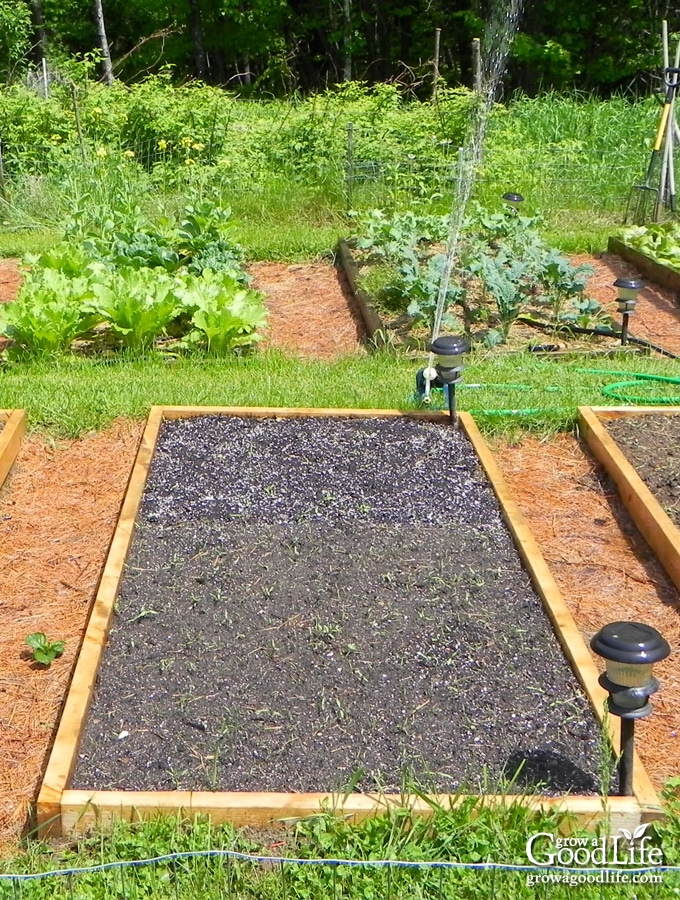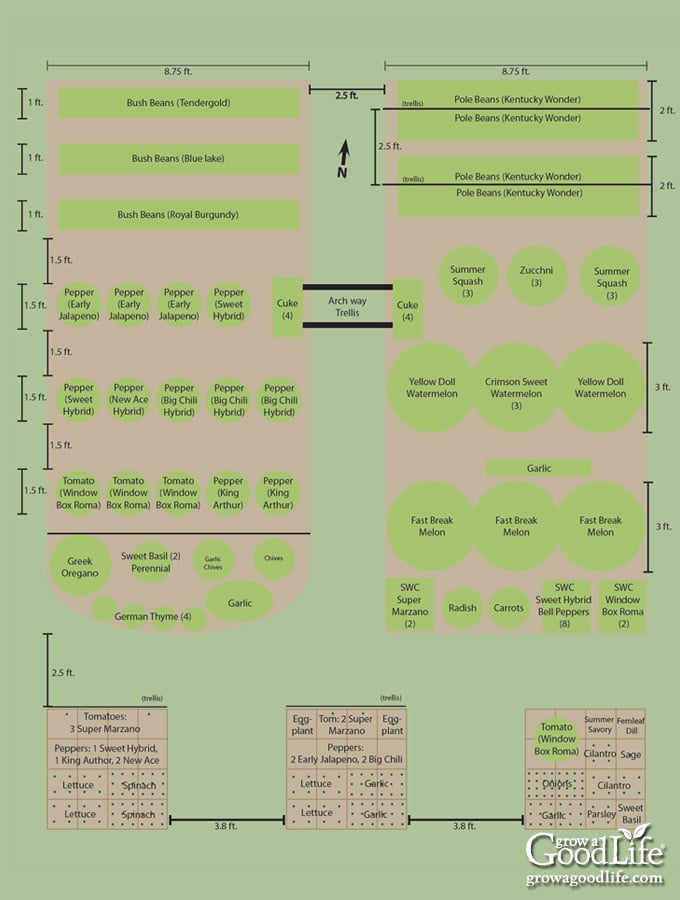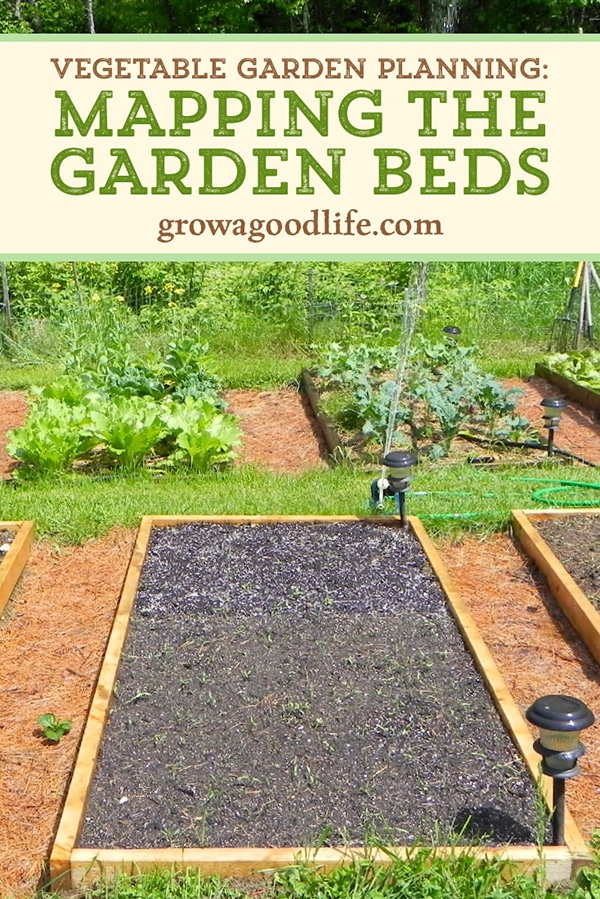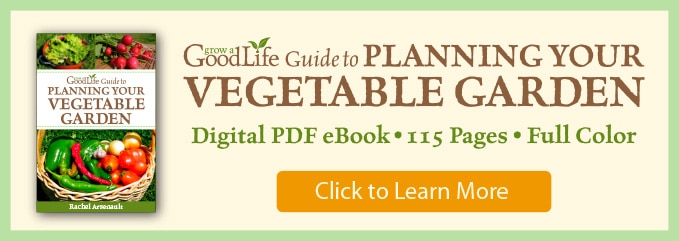Planning Your Vegetable Garden: Mapping the Garden Beds
This post may contain affiliate links, which means that I may receive a commission if you make a purchase using these links. As an Amazon Associate I earn from qualifying purchases.
Mapping your vegetable garden before planting helps you see how many seedlings you need, where they will be planted, and how you can keep each bed producing all through the growing season.

Late winter is the perfect time to plan your vegetable garden. After enduring snowstorms and cold temperatures for months, I begin wondering whether spring will ever come at all.
Thoughts of warmer days and fresh garden harvests encourage me to the next step in planning a vegetable garden: Mapping the Garden Beds.
After organizing your seed box, paging through the catalogs thinking about what to grow, and making a seed wish list, the following step is to figure out how everything will fit into the garden.
Things to consider when planning the garden beds
Before sowing a single seed, it is helpful to sketch a map of the garden so you know how many seedlings you will need, where they will be planted, and how you can keep each bed producing all through the growing season.
Plant Spacing
Don’t be tempted to overcrowd your garden. Each plant requires a certain amount of space to grow healthy and produce an abundant harvest. Plants that are too close together will compete for nutrients, moisture, and airflow.
Overcrowded plants will actually produce less and become more susceptible to pests and diseases. Follow the recommended plant spacing specified on the seed packages.
Crop Rotation
It is beneficial to rotate plant families from one garden bed to another each growing season. Vegetables that are in the same family use similar nutrients and are vulnerable to the same pests and diseases. Planting different crop families from year to year helps to avoid depleting the soil and prevents crop specific pests and diseases from building up from one season to the next. In my garden, I focus on five vegetable plant families for rotation planning purposes:
- Allium Family: chive, garlic, leeks, onions, and shallots.
- Solanaceae Family: eggplant, peppers, potatoes, tomatillo and tomatoes.
- Brassica Family: broccoli, cabbage, cauliflower, collards, kale, kohlrabi, mustard greens, radish, rutabaga, spinach, and turnip.
- Cucurbit Family: cucumbers, gourds, melons, pumpkin, and squash.
- Legume Family: beans and peas.
The plants in each family are grouped together and planted in the same beds, so I can easily move them to a different bed the following year. Other vegetables such as lettuce, corn, carrots, and herbs are worked in where there is room, but I try not to plant them in the same spots two years in a row.
Growing Vertical
Tall trellised plants such as peas, pole beans, and indeterminate tomatoes are limited to the north end of the garden beds, so they don’t shade other plants.
- Learn More: 9 Creative DIY Trellis Ideas
Succession Planting
Even in my Maine Zone 5 garden, I can grow up to three crops in the same garden space if schedule carefully. Quick growing crops such as spinach, lettuce, and other various greens can be planted in spring. Once the warmer weather arrives, spring greens usually turn bitter and bolt. These can be removed, fed to the chickens, and the space used to grow bush beans. Once the bush beans are finished producing, a fall crop of spinach, lettuce, and other cool-season crops are planted.
Winter Storage Inventory
The inventory of the preserved garden bounty from the previous year also factors into the amount of plants in the plan. I don’t weigh my harvests, but do keep notes on the number of plants grown from year to year. At the end of winter, I inventory what is left in storage and decide if I need to increase or decrease the number of plants grown to provide us with enough preserved food until the following years garden begins to produce.
- Learn More: 9 Crops to Grow for Winter Food Storage
How to Map the Vegetable Garden Beds
Planning begins with a blank garden diagram and the list of plants that you want to grow.
Before you begin plotting out your garden layout, review the list of crops you want to grow, decided roughly how many plants of each vegetable you would like to raise, and review the seed package to see how much area each plant will need.
The way you approach mapping out your garden beds will depend on your priorities.
- Learn More: Choosing What to Grow in the Garden
For example, we rely heavily on canned tomato sauce, canned salsa, and frozen tomatoes to use in soups and stews. So tomatoes, peppers, onions, and garlic are considered necessities in the garden and take priority on the garden space.
I begin with these crops and plot out where they will be planted for the new season. Then I move on to other crops that will need trellis supports and extra space to grow. Finally, I fill in with short seasoned spring crops along with what will be planted once these crops are finished.

Step 1: Sketch the Garden Area
First, make a sketch of the garden area showing the dimensions of your garden beds. This can be done on a computer program or simply drawn out on graph paper.
Step 2: Plot the Plants on the Map
Refer to your seed list and begin arranging the crops in the garden map. Use square foot garden spacing or the recommended space between plants indicated on the back of your seed package to estimate how many plants you can grow in an area.
Step 3: Start with High Value Crops
Start plotting your garden with the crops you consider important. For example, tomatoes, peppers, onions, and garlic are very high value in our garden. These are plotted first on my garden map to ensure there is plenty of room to grow enough of these crops for preserving.
Remember to account for crop rotation and avoid planting the same plant families in the area they grew last year.
Step 4: Decide Which Vegetables to Grow Vertically
Move on to crops that need trellis supports to grow. Remember tall crops should grow on the north side of your beds, so they don’t shade other plants.
Plan out where you will grow your indeterminate tomatoes, cucumbers, pole beans, peas, and other crops that will benefit growing with supports.
Step 5: Give Vining Crops Plenty of Room
Vining crops, such as squash, pumpkins, and melons will need plenty of room to sprawl. Be sure to locate these plants in an area where they can grow long vines without smothering other plants. I like to plant these along the edges of my garden beds and let the vines trail out into the paths if they need to.
Step 6: Fill in With Other Crops
Finally, fill in with short seasoned spring crops along with what will be succession planted in summer and fall once these crops are finished. For example, spinach, lettuce, and salad greens will grow in spring, and then replant the beds with bush beans when the spring crops are finished growing, followed by cool season crops again in fall.
Tuck in a few herbs and flowers where space allows, but avoid overcrowding your plants so they have plenty of space to grow strong.
—
There you have it! A general idea of how your vegetable garden will be planted in the spring. This plan may change come planting time and as the season progresses, but this is great starting point.
Mapping the garden beds each year will help give you a plan to follow, making it easy to figure out the amount of seeds and seedlings you will need to fill the space.
In addition, mapping the garden beds provides a record of what was planted in each location from year to year to help with crop rotation for next year.
The next step in Planning Your Vegetable Garden -> How to make a planting and seed-starting schedule so you know when to sow your seeds.
You May Also Like:
- How to Build Raised Beds
- Vegetables to Grow in Shady Gardens
- 10 Steps to Starting Seedlings Indoors
- Crops to Direct Sow in the Garden
Good planning is key to a successful vegetable garden
Whether you are new to growing your own food or have been growing a vegetable garden for years, you will benefit from some planning each year. You will find everything you need to organize and plan your vegetable garden in my PDF eBook, Grow a Good Life Guide to Planning Your Vegetable Garden.



This post had a lot of good ideas for any gardener. I have been working on learning more about single subjects. Right now I’m focused on composting do’s and don’ts. I’ve never done composting before. I’ve also started a garden journal to keep track of information. Looking forward to seeing more of your posts.
Thank you, Lori. One thing I have learned about making compost is not to overcomplicate the process. Even if you don’t do anything to your bin but add random composting material, it will eventually break down and turn into compost. Unfortunately, I don’t have an article yet on making compost, but you may like to explore this article on Building Healthy Garden Soil.
I’m a mainer, COME HELP ME!! Lol kidding, not kidding.
Thanks for this!
It does seem overwhelming in spring even for the seasoned gardener. I’m still getting the garden in and this heat and humidity is making it challenging. You’ll be fine. 🙂
This has been extremely helpful! We moved last year and our first garden here didn’t do very well. This year, I’m following your guide to set up my garden beds and plants. Thank you!!
Janelle, I am so happy this helps. I hope you enjoy an abundant harvest this year.
Thank you for this comprehensive article on how to map out beds. I have struggled year to year to maximize the space I have and this has helped me so much! I am also in zone 5 and this is exactly what I needed to plan my garden!
Natalie, I am so glad this was helpful to you. It makes it so easy at planting time.
What computer program do you use to map out your gardens? Right now I sketch but I’d like to find a program where things are measured and spaced to scale. Any suggestions?
Jaclyn, If you do a search, you will discover that there are a number of online garden planning tools. I can’t advise you because I haven’t tried any of them for myself. I just use a simple spreadsheet program.
You can use any type of spreadsheet software such as Microsoft Excel or Google Sheets to design your garden. Just set it up as a grid, measure, and lay out your garden beds. Here is a great tutorial: http://everchanginggarden.ca/draw-your-own-garden-plan-without-expensive-garden-design-software/
Google also has a freestyle drawing program, called Google Drawings that looks as easy to use as sketching it out on paper. Once you have a template, you can use it to map out your garden beds for years to come.
Do you include the lettuce family in the with brassica family?
Where do you include roots such as beets and carrots?
Nancy, I just work in lettuce, beets, and carrots where there is room.
What kind of wood do you use for garden beds?
Untreated pine and hemlock. Hemlock lasts much longer.